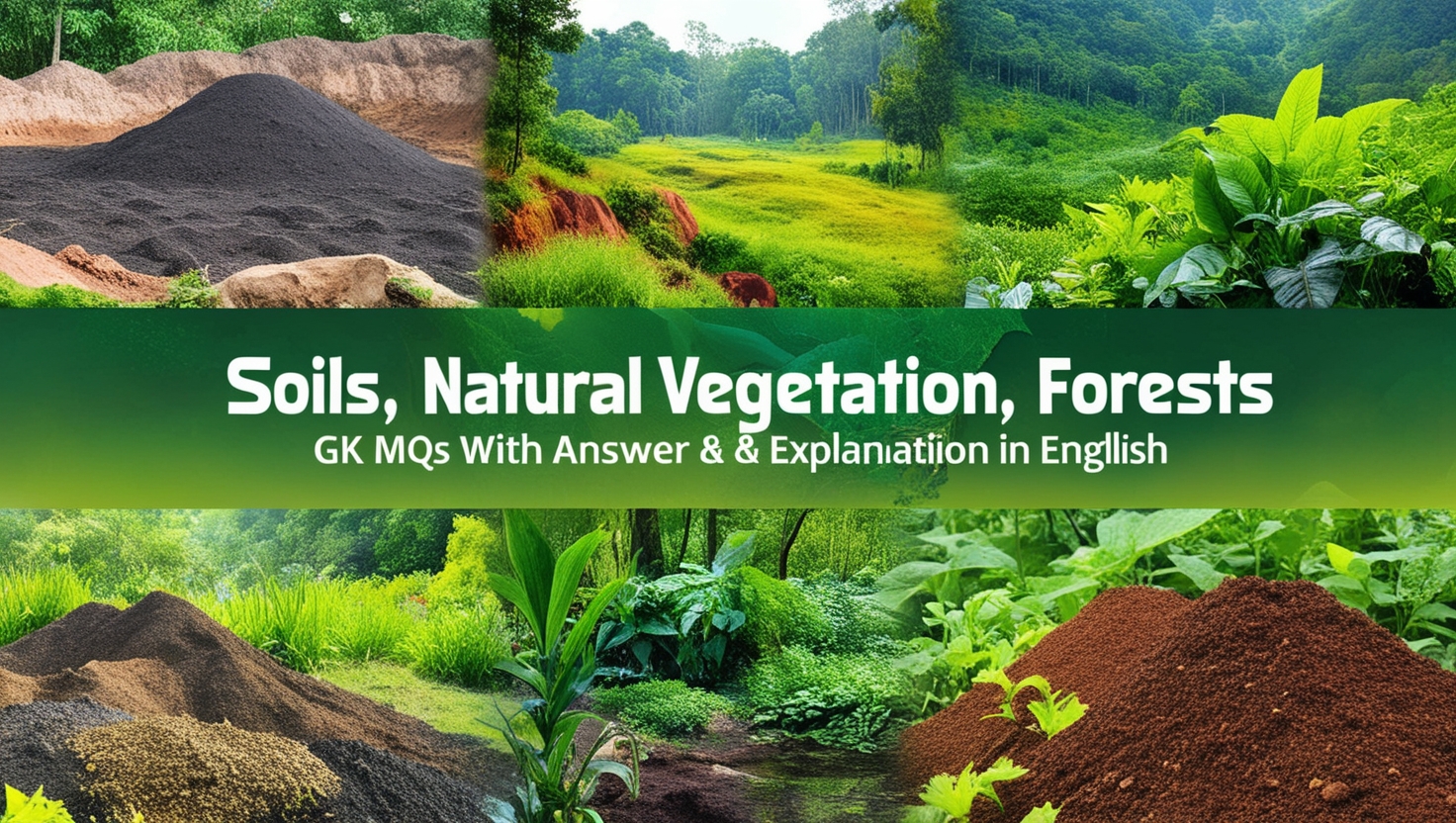
Understanding the different types of soils, natural vegetation, and forests is crucial for environmental studies and general knowledge. In this article titled Soils, Natural Vegetation, Forests GK MCQs With Answer & Explanation in English, we present a comprehensive set of multiple-choice questions designed to test and enhance your knowledge on these vital topics.
Each question is followed by a detailed explanation to help you grasp key concepts easily.
1. Which of the following is related to the Dampier-Hodges line?
- Bay of Cambay
- Palk Strait
- Andaman and Nicobar Islands
- Sundarbans
Show Answer
Answer: Sundarbans
The Dampier-Hodges Line is indeed an imaginary line that marks the northern boundary of the Sundarbans delta in West Bengal. This ecologically important region is known for its vast mangrove forests and unique biodiversity. The line delineates the extent of this deltaic ecosystem and plays a crucial role in conservation efforts.
2. Which type of forests occupies the highest percentage of area in India?
- Tropical deciduous
- Savanna and desert vegetation
- Equatorial evergreen
- Tropical Rainforests
Show Answer
Answer: Tropical deciduous
Tropical Deciduous Forests, often referred to as “Monsoon forests,” cover a significant portion of India’s land area. These forests thrive in regions with an annual rainfall ranging from 70 to 200 cm. They are characterized by a variety of tree species, including Sandalwood, Shisham, Mahua, Sal, Teak, and Bamboo. The deciduous nature of these forests means that the trees shed their leaves during the dry season and regain them with the onset of the monsoon, hence the name “Monsoon forests.”
3. Which of the following is NOT a correct statement about Alluvial soil?
- Alluvial soil is the most abundant type of soil found in India.
- Alluvial soil is generally fertile.
- Alluvial soil lacks nitrogen and tends to be phosphoric.
- Alluvial soil generally comprises a high percentage of clay and retains moisture for a long time.
Show Answer
Answer: Alluvial soil generally comprises a high percentage of clay and retains moisture for a long time.
The statement that alluvial soil is known for its high fertility and typically contains a mixture of sand, silt, and clay is accurate. Alluvial soil is one of the most fertile soil types in India and is often found in the floodplains of major rivers like the Ganges, Brahmaputra, and their tributaries. Its composition of sand, silt, and clay, along with rich organic matter, makes it suitable for various agricultural crops.
4. Which among the following is considered to be the best soil for plant growth?
- Sand
- Clay
- Loam
- Silt
Show Answer
Answer: Loam
Loam soil is indeed considered one of the best soil types for plant growth. It is a balanced mixture of sand, clay, and humus (organic matter). Loam soil has excellent water-retaining capacity, is well-aerated, and contains adequate mineral salts required for plant growth. Due to these properties, it provides an ideal environment for a wide range of crops.
5. The word “Mangal” is used for which among the following kinds of vegetations?
- Aquatic Plants
- Algal Blooms
- Mangroves
- Mediterranean forests, woodlands, and scrub
Show Answer
Answer: Mangroves
The term “Mangal” is used to describe the entire ecosystem of mangrove forests, encompassing not only the plant species but also the diverse community of organisms that inhabit these coastal ecosystems. This includes various fish species, crabs, mollusks, and other animals that rely on mangroves for shelter, breeding, and feeding. Mangrove plants are an integral part of the mangal ecosystem, as they serve as a foundation for the entire food web in these unique habitats.
6. Which among the following soil is predominantly found in the Rarh Region of West Bengal?
- Alluvial Soil
- Red Soil
- Black Soil
- Acid Sulfate Soil
Show Answer
Answer: Red Soil
The Rarh region of West Bengal is indeed known for its red soil, which is commonly referred to as “laterite soil.” This soil type is characterized by its reddish appearance due to the presence of iron and aluminum oxides. Laterite soil is well-suited for certain types of crops but may require proper management and nutrient supplementation for optimal agricultural productivity.
7. For cotton cultivation, which among the following soils is considered most suitable?
- Red Soil
- Black Soil
- Laterite Soil
- Alluvial Soil
Show Answer
Answer: Black Soil
Black soil, also known as regur soil, is renowned for its moisture retention capacity. This soil type is particularly suitable for cotton cultivation because it can hold moisture well, which is crucial for cotton plants. Its ability to retain moisture provides a favorable environment for cotton growth and development.
8. Sundarbans in India is a fine example of which kind of forests?
- Dry Forests
- Deciduous Forests
- Tidal Forests
- Wet Deciduous Forests
Show Answer
Answer: Tidal Forests
The Sundarbans, located in India and Bangladesh, is a prime example of tidal forests. These forests thrive in deltaic regions where rivers like the Ganga, Mahanadi, Godavari, and Krishna meet the Bay of Bengal. The Sundarbans is inundated by tidal waters and high sea waves during high tides, creating a unique ecosystem where salt-tolerant mangrove trees dominate.
9. Which among the following types of soil has the largest area covered in India?
- Alluvial
- Black
- Red
- Laterite
Show Answer
Answer: Alluvial
Alluvial soils, formed by the deposition of sediments carried by rivers, indeed cover a substantial portion of India’s land area, approximately 40%. They are widespread in the fertile floodplains of rivers such as the Ganges, Brahmaputra, and their tributaries. Due to their rich composition of sand, silt, and clay, alluvial soils are highly fertile and conducive to a variety of agricultural crops.
10. How many states in India have a forest cover of more than 75% of their geographical land area?
- 1
- 3
- 5
- 7
Show Answer
Answer: 3
Arunachal Pradesh, Manipur, and Nagaland are indeed states in India with forest cover exceeding 75% of their total land area. These northeastern states are characterized by their dense and diverse forest ecosystems, contributing significantly to India’s overall forested area.







